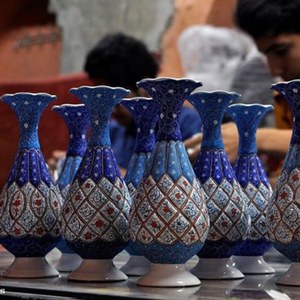The origin of the blue and white decorative style is thought to lie in Persia when craftsmen in Basra sought to imitate imported white Chinese stoneware with their own tin-glazed, white pottery and added decorative motifs in blue glazes that had been developed by pre-existing Mesopotamian cultures. Although blue was always popular in Persia cobalt blue glaze became popular in Islamic pottery during the Abbasid Caliphate, during which time the cobalt was mined near Kashan, Oman, and Northern Hejaz. Such Abbasid-era "blue and white" pieces have been found in present-day Iraq dating to the 9th century A.D.
During the same period the first Chinese blue and white wares were produced in Henan province, China during the Tang Dynasty, albeit in very small quantities. It is difficult to determine who influenced who, but our bet is on the Persians influencing Chinese artisans because in Persia blue was a favourite in glazing and China green was the favourite, Persia was also the source of blue used in glazing. Whatever the answer, blue and white pottery ceased after the Tang Dynasty when the artistic emphasis of Song Dynasty pottery was on subtle glaze effects and graceful shapes. What is clear is that in the Song Dynasty which tended to uphold the esthetics of conventional Confucianism, underglaze blue was not at all popular; Confucian esthetics emphasized simplicity and the underglaze blue designs were judged to be too ornamental. Later, in China, a style of decoration based on sinuous plant forms spreading across the object was perfected and most commonly used.
It was thanks to the Mongol Yuan Dynasty that blue and white decoration (a typically Persian favourite) first became widely used in Chinese porcelain in the 14th century after the cobalt pigment for the blue began to be imported from Persia, since the Mongol rulers revered Persian arts of all kinds. During their reign mass-production of fine, translucent, blue and white porcelain started at Jingdezhen, sometimes called the porcelain capital of China. This development was due to the combination of Chinese techniques and Islamic trade. The new ware was made possible by the cobalt from Persia combined with the translucent white quality of Chinese porcelain. Cobalt blue was considered as a precious commodity, with a value about twice that of gold. Motifs also draw inspiration from Islamic decorations. A large portion of these blue-and-white wares were then shipped to Southwest-Asian markets through the Muslim traders based in Guangzhou.
With the advent of the Ming dynasty in 1368, blue and white ware was shunned for a time by the Court, especially under the Hongwu and Yongle Emperors, as being too foreign in inspiration. Blue and white porcelain however came back to prominence with the Xuande Emperor, and again developed from that time on. Some blue and white wares of the 16th century were characterized by Islamic influences, such as the ware under the Zhengde Emperor (1506–1521), which sometimes bore Persian and Arabic script, due to the influence of Muslim eunuchs serving at his court.



